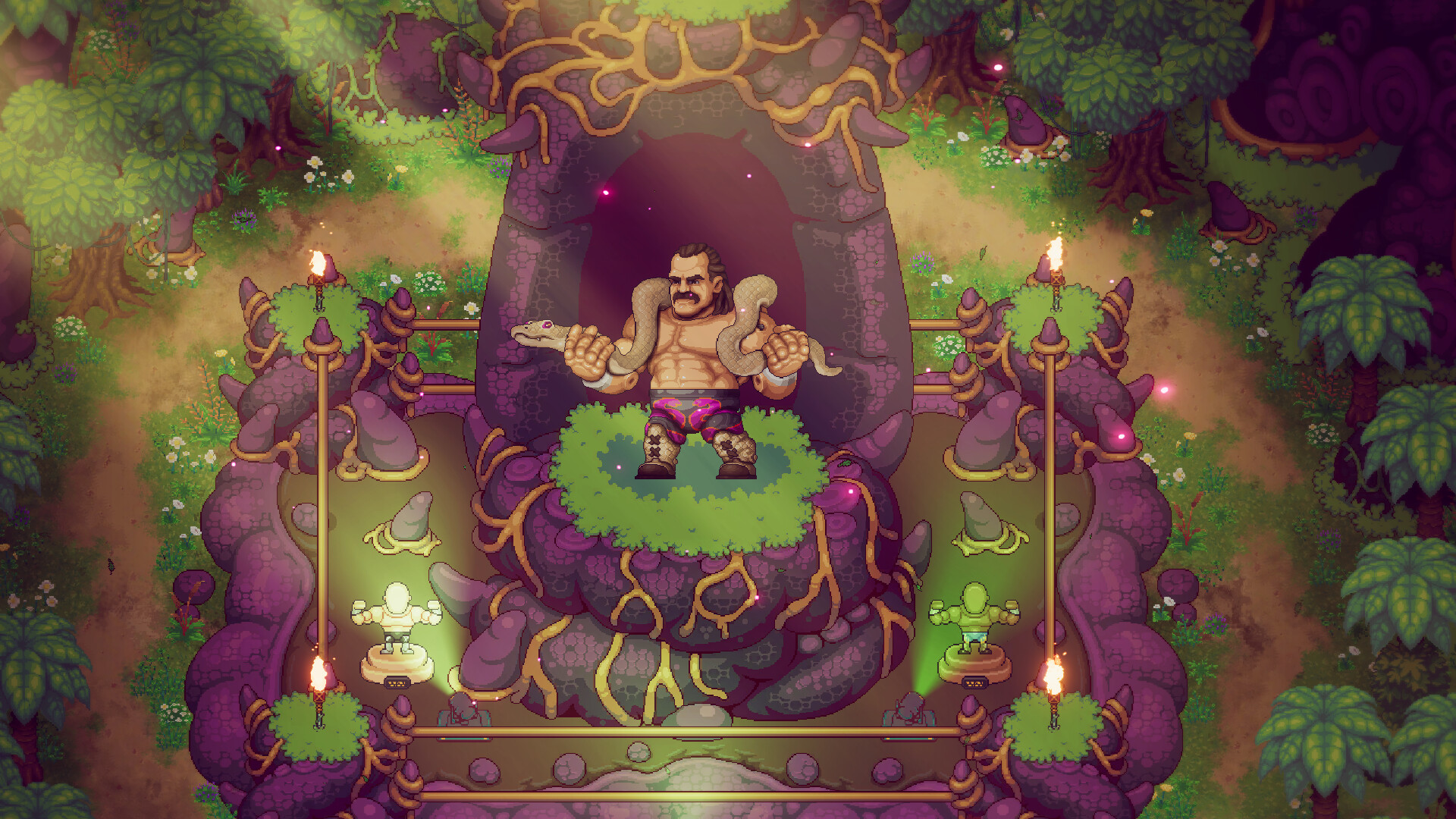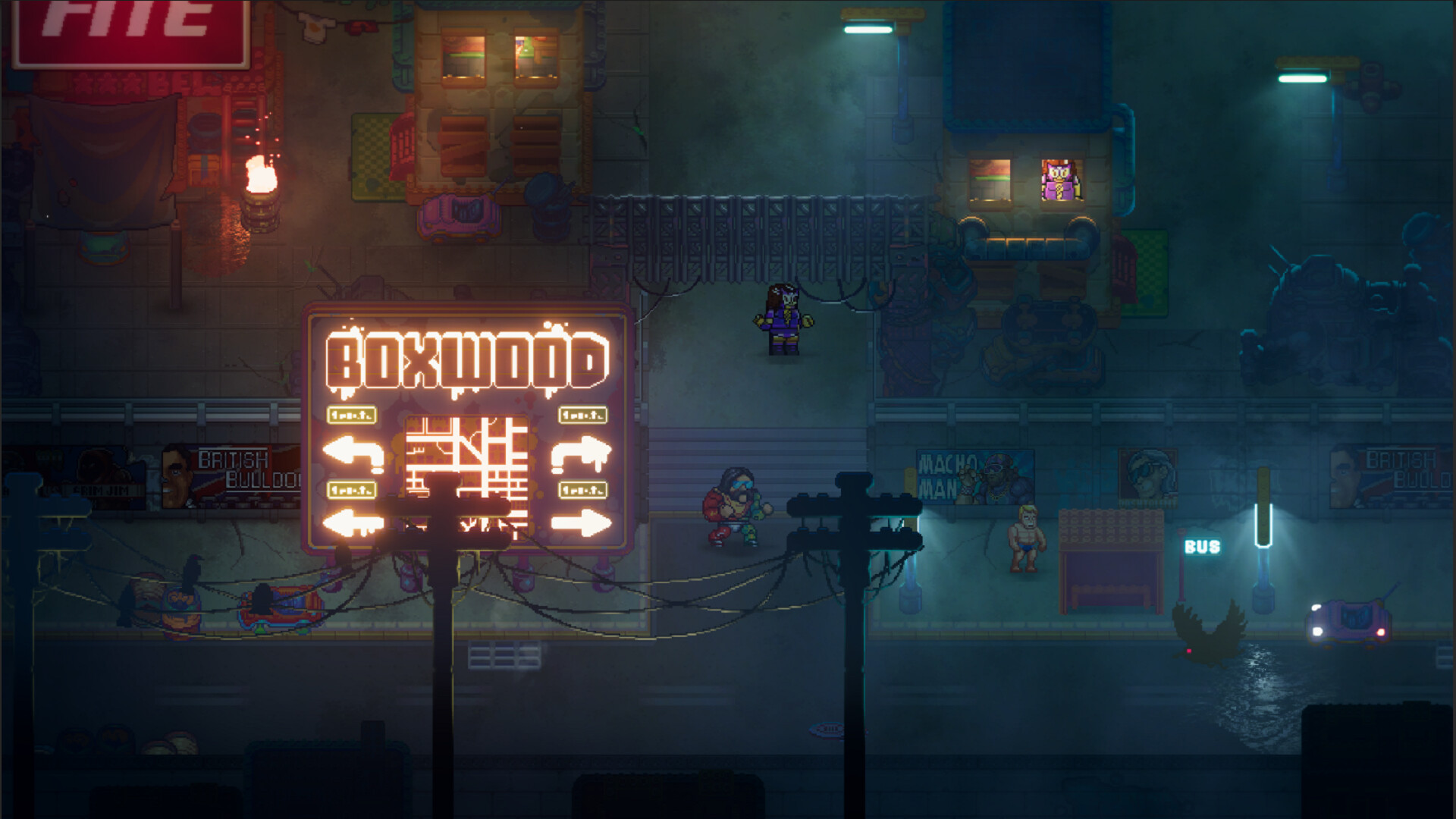Traditionally, wrestling games have never really escaped the fighting genre. In some shape or form, wrestling games always end up being competitive fighting games between 2 or more players, with few developers exploring the wrestling medium with the use of other gaming genres. Mega Cat Studios is the first developer I’ve really seen take an interesting approach to the traditional wrestling game, this time around wrapping it up in the gameplay of a traditional turn-based RPG, and that’s what we get with WrestleQuest.
First and foremost, WrestleQuest feels like a game developed by and for fans of professional wrestling. Not only does the title have an immense level of respect for real-life legends of the industry, like “Macho Man” Randy Savage and Jake “The Snake” Roberts, but it also backs up this fans service with some unique gameplay, as well as a fun, interesting story telling us about the journeys of new and upcoming wrestlers through their careers.
The most interesting thing about WrestleQuest, however, is its gameplay. Sure, it might just seem like a traditional turn-based JRPG, but there’s a surprising amount of depth available for anyone to dig through, since wrestling can often be an incredibly complex business if you start looking behind the scenes. For example, not only do you have the classic options of attacks and using items, but you also have the ability to unleash devastating signature moves through the use of gimmicks, or setting up awesome tag-team tandem offensive moves. All of these combat options tie into the game’s Hype system.
“It also backs up this fan service with some unique gameplay, as well as a fun, interesting story”
When it comes to combat abilities, you get quite a few options to choose from, assuming you have the AP for it. If you want, you can kick off just about every fight by using Randy Santos’ South of the Border Stunner to try and fatigue them early on. Or you could slowly build up to it like you would see in an actual wrestling match, and finish things off with a glorious moonsault off the top rope.
Every time you get into a fight or a match, you have to also pay attention to the level of Hype your match is creating. Doing things like nailing your entrance moves and cutting promos adds to your Hype before the match. You can also equip your wrestlers with a Hype Type, allowing you to generate Hype in different ways, be it by doing power moves, putting your enemies in technical submission holds, or even just showboating by using the taunt ability. Having enough Hype at the end of a match gives you extra rewards, which can range from banal bonuses like extra cash or exp, to more interesting things like consumables and gear.
Of course, you aren’t just limited to regular singles and tag matches either. WrestleQuest can also throw gimmick matches at you if the situation calls for it, which match types like No Disqualification matches—where you can use weapons without problems—or ladder matches—where the objective is to climb a ladder and retrieve a reward—also come up from time to time. Thankfully, however, these gimmick matches seem to be more of a way to punctuate story beats or offer up some variety rather than constantly popping up as yet another fight.

“WrestleQuest can also throw gimmick matches at you if the situation calls for it”
Interestingly, matches important to the game’s story also tend to present you with a few extra objectives, some of which are just bonuses for extra rewards while others are mandatory to successfully complete the match. An early example is a tag team match where you have to do a series of moves before the scripted conclusion of the match kicks off. Through this, WrestleQuest is able to offer a clever take on the predetermined nature of professional-wrestling, which also tends to tie into the main driving story arc behind one of the protagonists.
The core RPG mechanics of WrestleQuest are rather simple—take part in enough fights or complete enough quests to get experience so that you can level up, which in turn also boosts your stat points. These stats can also be changed by making use of specific equipment, which in turn also tend to have different effects against elemental attacks. You can also change the nature of your regular attack by equipping different kinds of “hands” or “feet” to your character, allowing you to switch to not only between elemental attacks, but also between sharp and blunt attacks.

“At the very center of WrestleQuest is the question of whether professional wrestling is “real” or “fake”.”
Just about every single aspect of WrestleQuest indicates that the studio knows exactly what it’s doing when the game throws around words like “work”, “shoot”, or “gimmick”, since those words tend to have very specific meanings in the world of professional wrestling. Like I mentioned earlier in the review, the game also features a surprising number of wrestling legends, not only from the past, but also figures in the industry who are still have an active career, like Jeff Jarrett, who currently works at All Elite Wrestling, and Conrad Thompson—a figure well-known for being the host of several pro-wrestling podcast alongside other wrestlers.
At the very center of WrestleQuest is the question of whether professional wrestling is “real” or “fake”. This is perfectly embodied by our first protagonist, Randy Santos, a wrestling rookie who is such a massive fan of the Macho Man that he often likes to punctuate his sentences with an “Oh si!” On the other side of the coin, we have the tag team of the Logan Brothers in Brink and Stag Logan—a duo that’s hoping to make it into the big leagues after paying their dues and taking scripted loss after loss in an effort to help their father’s wrestling company.
Of course, the whole story is wrapped up in the conceit that all of this seems to be taking place in a world populated by sentient toys. Wrestlers are action figures, and characters can range from being a nod towards Barbie, to a knock-off Mr. Potato Head, to even just straight up dinosaur toys. This also means that just about every location in the game is made to look like it’s in a toybox, from the piles of coffee cream at the base of a Randy Savage statue to the underbelly of Box Town.

“The use of the toy aesthetic also means that there’s a refreshing variety in the game’s various settings”
This wonderful aesthetic makes exploring the overworld in WrestleQuest an absolute joy, since you get to see a toy box-styled interpretation of what a city would look like. The use of the toy aesthetic also means that there’s a refreshing variety in the game’s various settings, from the green pastures of the early zones to the icy zones of the northern territories. It certainly also helps that every zone tends to have its own distinct take on the wrestling arena, which goes a long way in also offering some visual variety in the fights you’ll often find yourself getting into.
WrestleQuest quite honestly feels like a love-letter to professional wrestling. Not only does it feature an absurd level of fan service, especially for fans of classic wrestling, but it also manages to tell fun and interesting stories about the nature of the pro-wrestling business, all wrapped up in a wonderful aesthetic that manages to offer the perfect balance between the game’s serious moments and the more comedic bits. Throw on top a simple-but-robust RPG system that rewards understanding the ebb and flow of a typical wrestling match, and you get one of the most interesting takes on the wrestling medium in video game form out there.
This game was reviewed on PC.
WrestleQuest Review – Cream of the Crop
Source: News Beginning

0 Comments